
Baroque architecture is a highly decorative and theatrical style which appeared in Italy in the late 16th century and gradually spread across Europe. It was originally introduced by the Catholic Church, particularly by the Jesuits, as a means to combat the Reformation and the Protestant church with a new architecture that inspired surprise and awe. It reached its peak in the High Baroque (1625–1675), when it was used in churches and palaces in Italy, Spain, Portugal, France, Bavaria and Austria. In the Late Baroque period (1675–1750), it reached as far as Russia, the Ottoman Empire and the Spanish and Portuguese colonies in Latin America. In about 1730, an even more elaborately decorative variant called Rococo appeared and flourished in Central Europe.

Johann Bernhard Fischer von Erlach was an Austrian architect, sculptor, engraver, and architectural historian whose Baroque architecture profoundly influenced and shaped the tastes of the Habsburg Empire. His influential book A Plan of Civil and Historical Architecture (1721) was one of the first and most popular comparative studies of world architecture. His major works include Schönbrunn Palace, Karlskirche, and the Austrian National Library in Vienna, and Schloss Klessheim, Holy Trinity Church, and the Kollegienkirche in Salzburg.
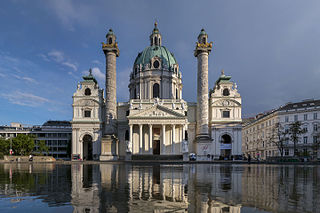
The Rektoratskirche St. Karl Borromäus, commonly called the Karlskirche, is a Baroque church located on the south side of Karlsplatz in Vienna, Austria. Widely considered the most outstanding baroque church in Vienna, as well as one of the city's greatest buildings, the church is dedicated to Saint Charles Borromeo, one of the great counter-reformers of the sixteenth century.
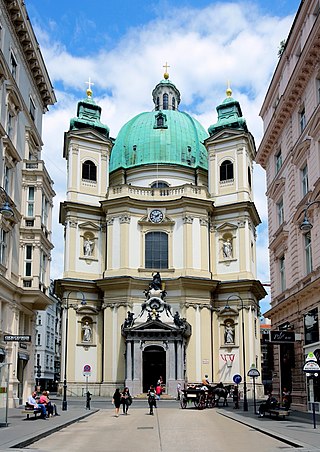
The Peterskirche is a Baroque Roman Catholic parish church in Vienna, Austria. It was transferred in 1970 by the Archbishop of Vienna Franz Cardinal König to the priests of the Opus Dei.

The Plague Column, or Trinity Column, is a Holy Trinity column located on the Graben, a street in the inner city of Vienna, Austria. Erected after the Great Plague epidemic in 1679, the Baroque memorial is one of the best known and most prominent sculptural artworks in the city. Christine M. Boeckl, author of Images of Plague and Pestilence, calls it "one of the most ambitious and innovative sculptural ensembles created anywhere in Europe in the post-Bernini era."

Matthias Steinl was an Austrian painter, architect and designer, and one of the country's best known Baroque sculptors. Together with Johann Bernhard Fischer von Erlach (1656–1723) and his rival Johann Lukas von Hildebrandt (1668–1765), Steinl may be considered one of the most influential architects to introduce the High Baroque style to Austria.
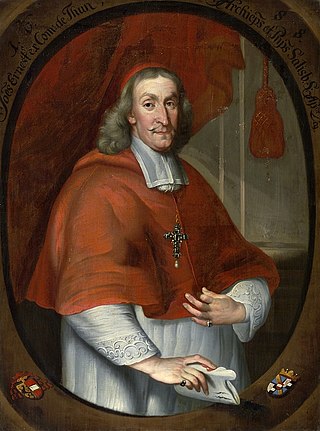
Johann Ernst Graf von Thun und Hohenstein was Bishop of Seckau from 1679 to 1687 and Prince-archbishop of Salzburg from 1687 until his death.
The year 1707 in architecture involved some significant events and new architectural works.
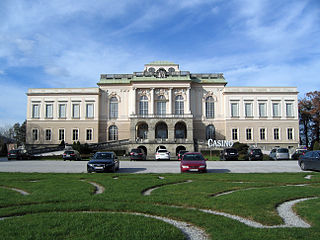
Schloss Klessheim is a Baroque palace located in Wals-Siezenheim, 4 km (2.5 mi) west of Salzburg, Austria. The palace was designed and constructed by Austrian architect Johann Bernhard Fischer von Erlach for Prince-Archbishop Johann Ernst von Thun in 1700. It became the summer residence of the Archbishops of Salzburg. Since 1993, the palace has been used by Salzburg Casino.

Herzogenburg Monastery is an Augustinian monastery located in Herzogenburg in Lower Austria. Founded in 1112 by Augustinian Canons, the monastery was refurbished in the Baroque style in 1714 by Jakob Prandtauer, Johann Bernhard Fischer von Erlach, and Josef Munggenast.

Ljubljana Cathedral, officially named Saint Nicholas's Church, also named Saint Nicholas's Cathedral, the Cathedral of Saint Nicholas, or simply the Cathedral, is a cathedral in Ljubljana, the capital of Slovenia. Originally, Ljubljana Cathedral was a Gothic church. In the early 18th century, it was replaced by a Baroque building. It is an easily recognizable landmark of the city with its green dome and twin towers and stands at Cyril and Methodius Square by the nearby Ljubljana Central Market and Town Hall.
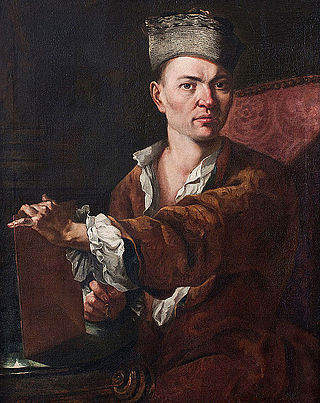
Paul Troger was an Austrian painter, draughtsman, and printmaker of the late Baroque period. Troger's illusionistic ceiling paintings in fresco are notable for their dramatic vitality of movement and their palette of light colors.

Mirabell Palace is a historic building in the city of Salzburg, Austria. The palace with its gardens is a listed cultural heritage monument and part of the Historic Centre of the City of Salzburg UNESCO World Heritage Site.

Diego Francesco Carlone was an Italian sculptor.

Vranov nad Dyjí is a castle in the homonymic market town of Vranov nad Dyjí in the South Moravian Region, Czech Republic. It lies on the Thaya, 3 km (2 mi) north from the Austrian border close to Hardegg.

Czech Baroque architecture refers to the architectural period of the 17th and 18th century in Bohemia, Moravia and Silesia, which comprised the Crown of Bohemia and today constitute the Czech Republic.

The Franciscan Church is one of the oldest churches in Salzburg, Austria. The church is located at the intersection of Franziskanergasse and Sigmund-Haffner-Gasse opposite the Franciscan Friary in the Altstadt section of the city. The first church on this site was erected in the eighth century. Between 1408 and 1450, a Gothic choir replaced the Romanesque choir. A slender Gothic tower was added between 1468 and 1498. The church was dedicated to the Virgin Mary and served as the parish church until 1635. It was ceded to the Franciscan Order in 1642. Johann Bernhard Fischer von Erlach redesigned the church interior in the baroque style in the eighteenth century.

The Winter Palace of Prince Eugene, also known as the City Palace, is a high-Baroque palace in the Innere Stadt district of Vienna, Austria. Located on a narrow street at Himmelpfortgasse 8, the palace was used as the winter residence of Prince Eugene of Savoy, who spent his summers at the Belvedere. The Winter Palace was designed and constructed by Johann Bernhard Fischer von Erlach from 1695 to 1700, and by Johann Lukas von Hildebrandt from 1702 to 1724 following his predecessor's plans.
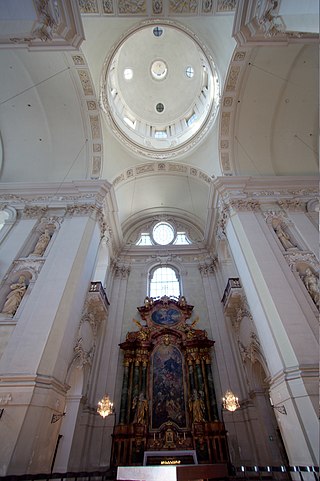
The Kollegienkirche in Salzburg, Austria, is the church of the University of Salzburg. It was built in Baroque style by Johann Bernhard Fischer von Erlach. Dedicated to the Immaculate Conception, it is part of the UNESCO World Heritage Site Historic Centre of Salzburg. It is now both the parish church of people connected to the university and a venue of the Salzburg Festival.



















